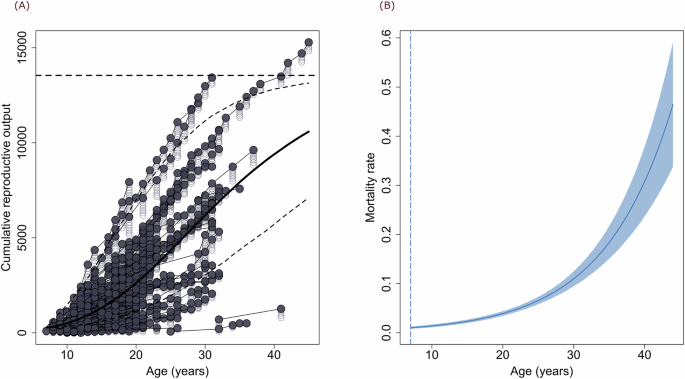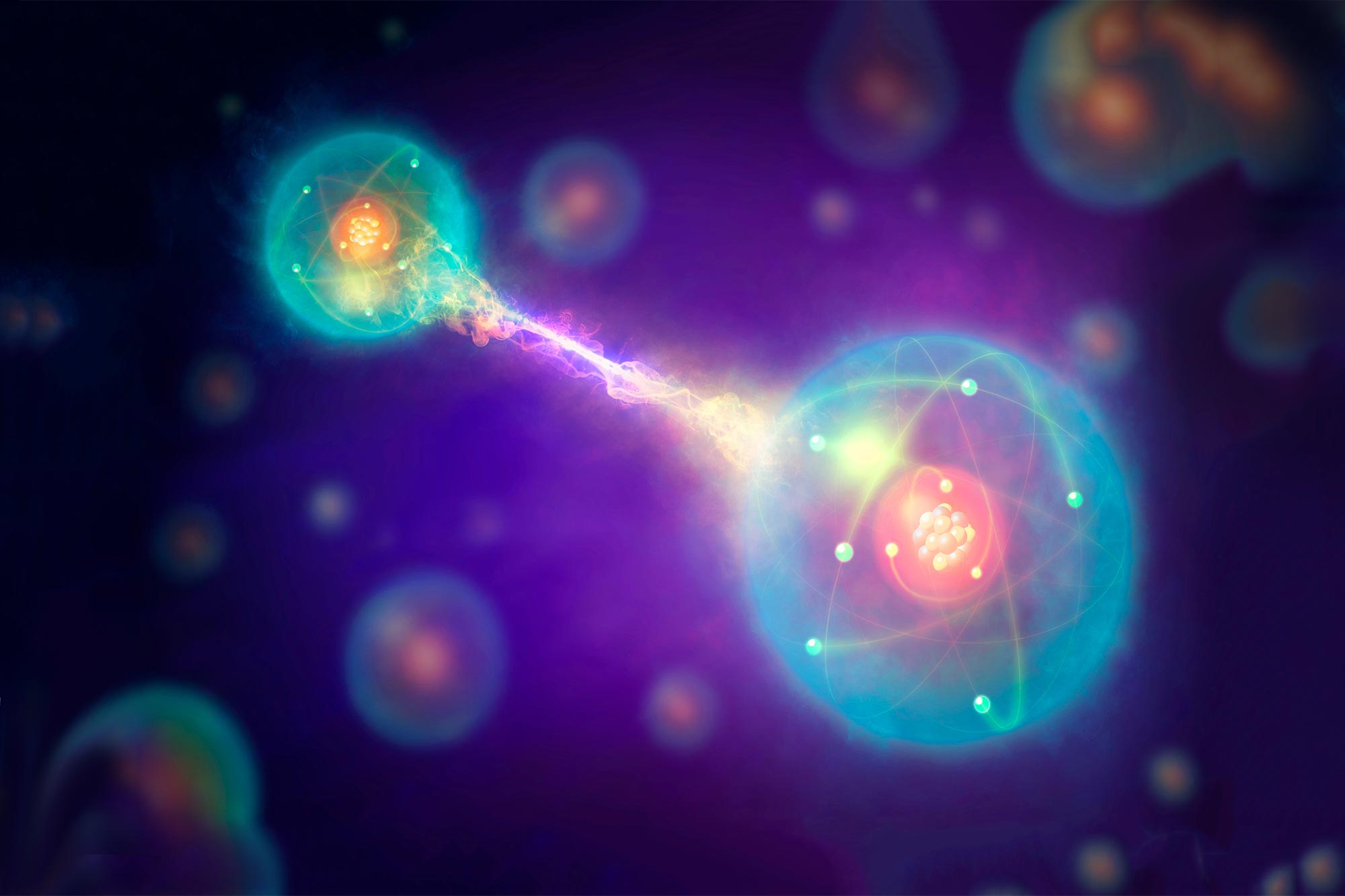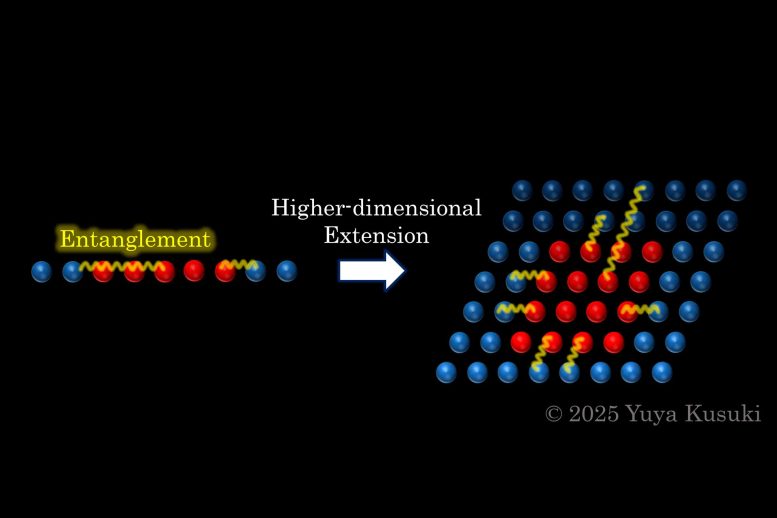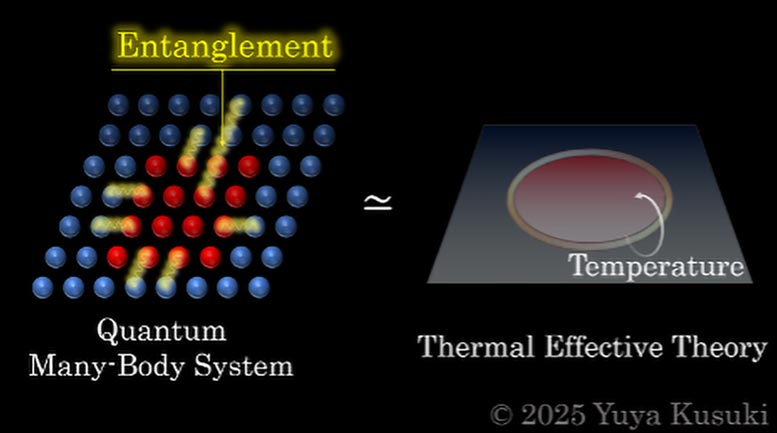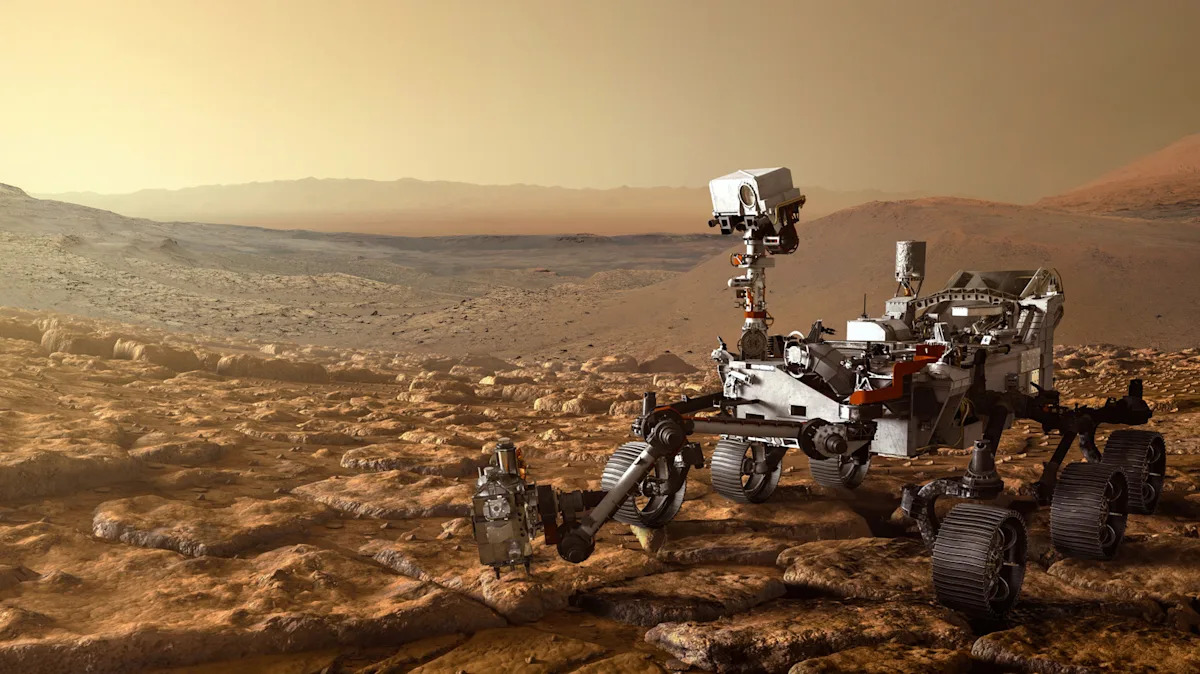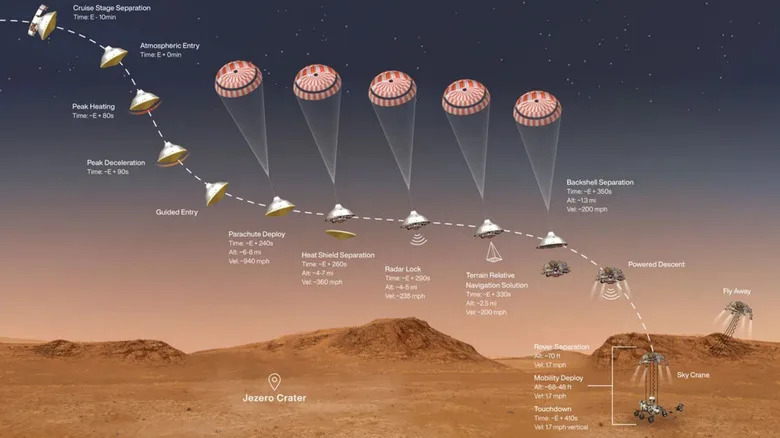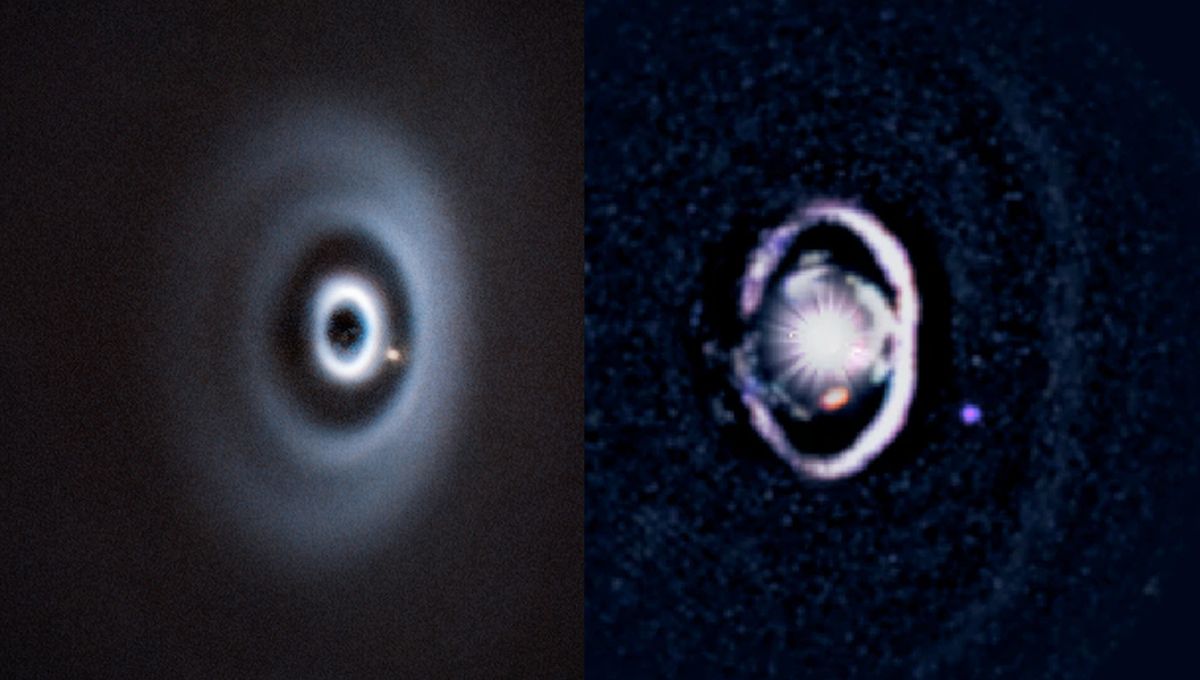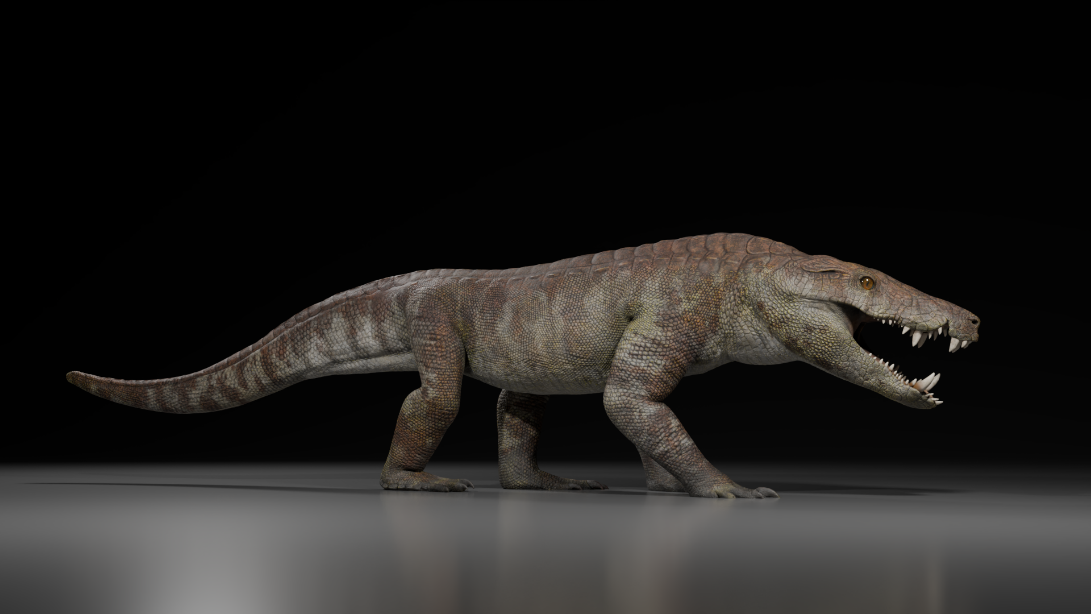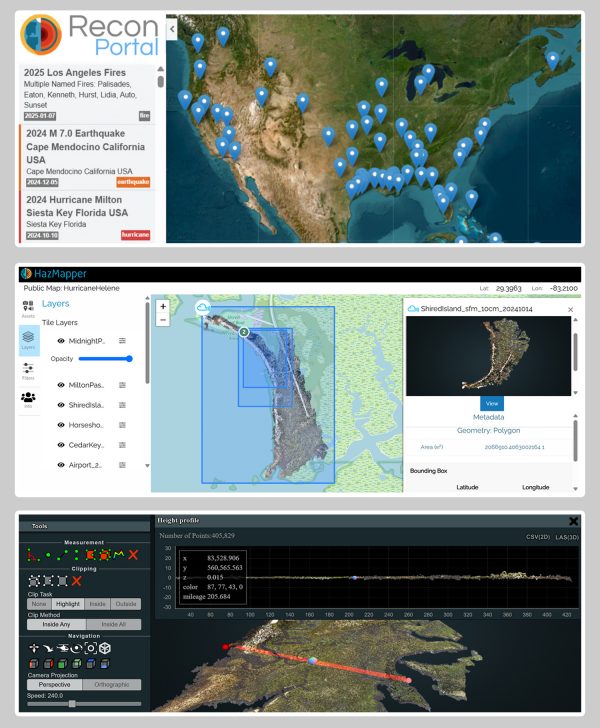Reproductive output does not decline with age in captive green turtles
At the population level, cumulative reproductive output increased by 13% of its current value per unit time (θ = 0.13; 95% CI: 0.12–0.14), which approximated an almost linear increase in reproduction from age 17 to 38 years of age (Fig. 1A; SI Appendix, Fig. S1). This reproductive pattern is consistent with other testudines, such as Blanding’s turtle Emydoidea blandingii23 and painted turtles Chrysemys picta24, which tend not to show age-related declines in clutch size and reproductive frequency (but see ref. 25). Longitudinal data on Mediterranean green turtles suggest a similar pattern, where the cumulative number of clutches increases linearly with time since their first breeding season26. Unfortunately, the animals used in their study were of unknown age, complicating direct comparisons with our results.
A Solid line represents the average change in cumulative reproductive output (number of eggs) with age and associated 95% CI (dashed line). Horizontal dashed line indicates the equilibrium value, ({{rm{kappa }}}). B Solid line shows age-specific changes in mortality and associated 95% CI (shaded area). Vertical dashed line represents the minimum age at first reproduction (AFR).
During a typical breeding season, female green turtles laid an average of 393 ± 238 eggs, distributed across 4.5 ± 2.0 clutches, though some individuals produced over 1000 eggs per season. Over their lifetime, females averaged a total reproductive output of 2602 eggs, with this distribution highly right-skewed and heavy-tailed. Importantly, new clutches were not clumped over time (Fig. 1A). As a result, the Poisson distribution provided a better fit to the reproductive data over competing models ((Delta {{{rm{SIC}}}}_{{{rm{GP}}}-{{rm{Poisson}}}}=2253.4); (Delta {{{rm{SIC}}}}_{{{rm{NB}}}-{{rm{Poisson}}}}=2.2)). A major factor affecting the temporal spread of reproduction is the duration between breeding seasons. In the wild, it is uncommon for females to reproduce in consecutive years27, but green turtles at the CTC have an average inter-breeding interval of 1.7 years (wild inter-breeding intervals: 2.9 and 3.2 years28,29). Factors associated with captivity – ad libitum feeding, higher quality resources, and access to suitable mates – may significantly reduce the physiological costs of reproduction but accelerate reproductive schedules. For instance, captive green turtles have a younger age at first reproduction (AFR) but reach maturity at a similar body size (measured via curved carapace length; CCL)30 to wild populations (CTC: CCL = 98.5 cm, AFR = 12.01 years; Australia (wild): CCL = 102.1 cm, AFR = 32 years31; Hawaii (wild): CCL = 94.0 cm, AFR = 27.3 years32). Only 29 of the 118 captive green turtles in Fig. 1 had an AFR less than 10 years old (range: 7–32).
At the population-level, we did not find evidence that a higher allocation to reproduction per year or a younger age at maturity33 led to an earlier deceleration in cumulative egg production. These findings are broadly consistent with Dynamic Energy Budget (DEB) models for Australian green turtles after the removal of resource limitation34. The main difference between captive and wild green turtles appears to be reproductive frequency, whereby predator-free, resource-rich captive conditions support the upper limit of their reproductive potential. However, such accelerated reproductive rates, in combination with accelerated growth rates30 could have contributed to a lower expected longevity post-maturity35 (see mortality results), which aligns with a well-supported prediction by Williams10,36. Rapid development is correlated with rapid senescence. On the other hand, the removal of environmental constraints may dampen or decouple trade-offs expected under natural conditions37,38, such as the correlation between longevity and aging rate39 or the covariance between lifespan, growth, and reproduction40,41. As such, any comparison with wild green turtle populations is currently speculative.
Observed differences in reproductive trajectories among captive turtles were mostly a result of individual heterogeneity (SI Appendix, Fig. S2). For example, four turtles laying over 10,000 eggs averaged two more clutches per year and returned to breed half a year sooner. While some individuals maintain high reproductive functioning at older ages, this may ultimately be curtailed by a rising probability of catastrophic death rather than a gradual decline in fitness42. In such cases, their reproductive lifespan is effectively truncated by mortality. The contribution of older turtles to the next generation could also decrease if developmental problems are more prevalent in elderly animals23,25. Thus, the actual number of offspring produced may decline with increasing egg production40,43. Unfortunately, we were unable to relate egg output to offspring production because hatchling data collection and egg incubation conditions were not consistent over the study period. Investigating the link between age-specific changes in egg production and offspring fitness is a critical area for future research.
Beyond 60 years old, average egg production was projected to stop, reaching a lifetime plateau at about (kappa =) 13,545 eggs (Fig. 1A; SI Appendix, Table S1). Yet, it is unknown if captive green turtles will live this long. Other environmental threats that are an indirect result of aging, such as increased susceptibility to disease44, may induce mortality in elderly females. Conversely, females reproducing into old age may be a result of the selective disappearance of low-quality individuals, i.e., selective disappearance effects45. Mortality selection alters the composition of older age classes by removing frailer individuals from the population. The strength of this mortality filter depends on the overall risk of death46. When the risk of death is high, fitter individuals disproportionately represent the oldest age classes. In captivity, mortality filters are generally weak, extending the lifespan of every individual40. However, a filter for reproductive lifespan could mirror a mortality filter in which the oldest individuals reproducing represent a specific subpopulation remaining after selective disappearance47. As natural selection weakens with age, it creates a window of optimal fertility, which varies in duration across individuals48. As a result, infertility in late life may arise from complex hormonal changes48, irrespective of increases in longevity.
Females experiencing a single reproductive season (Fig. 2), hereafter termed one-time nesters (OTN), are not an artifact of captivity but are also regularly observed in wild populations49. For instance, 35% of 1770 female loggerhead turtles Caretta caretta nesting on the South-Eastern US had only one observed reproductive event50. In our study, OTN accounted for 24% of the 156 females. Compared to multi-season nesters (MSN), OTN did not differ in age at first reproduction (∆MSN-OTN = 0.5 years, t59.8 = 0.7, p = 0.5). Notably, their single reproductive event incurred no detectable survival cost. OTN experienced a reproductive lifespan 52% shorter than MSN (see survival results below) but laid significantly fewer eggs in their first breeding season (∆MSN-OTN = 76.9 eggs, t72.1 = −2.5, p = 0.02) – a difference equivalent to nearly one full clutch. The fate of short-lived OTN may further point to a selective filter favoring an intrinsic physiological resilience needed for sustained reproduction, a capacity that remains crucial even in captive conditions.
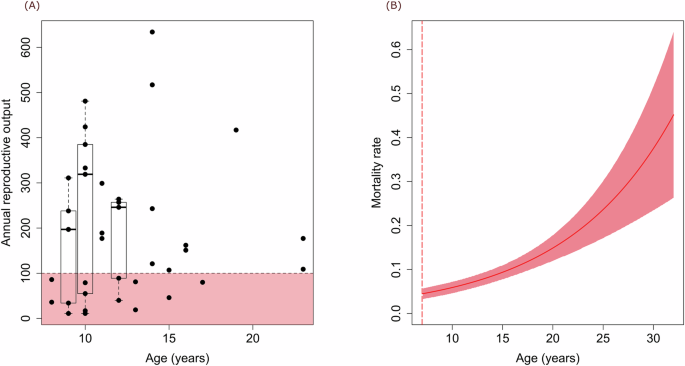
A Points represent observed annual reproductive output. Since each female only had one observed breeding season, the associated ages for each point represents age at first reproduction (AFR). Individuals that laid less than the average clutch size of 100 eggs are below the dashed line. B Solid lines show age-specific changes in mortality and associated 95% CI (shaded area). Vertical dashed line represents the minimum AFR.
Mortality rates in captive green turtles increase exponentially with age
Survival patterns for captive green turtles follow the Gompertz law, which posits that adult mortality rises exponentially – or linearly on the log-scale – with age after maturity51. This mortality pattern has also been observed in captive3 and wild4 testudines. As expected, captive green turtles have a low initial mortality rate (({{{rm{beta }}}}_{0}): 0.01 – 0.04) and a slow aging rate (({{{rm{beta }}}}_{1}): 0.09–0.10), similar to other testudine species3 and orders of magnitude lower than rates typical for birds and mammals (See Fig. 1 in refs. 4,40). However, aging rates for both groups [OTN and MSN] were strictly positive (Fig. 3) and significantly different from zero (p < 0.001), revealing green turtles can experience actuarial senescence even in protected environments. This may relate to growth slowing to an asymptotic size rather than continuing indefinitely throughout life. Female green turtles at the CTC reach 95% of their maximum mass and 85% of their maximum length at AFR30, limiting any potential benefits from increasing size on fecundity.
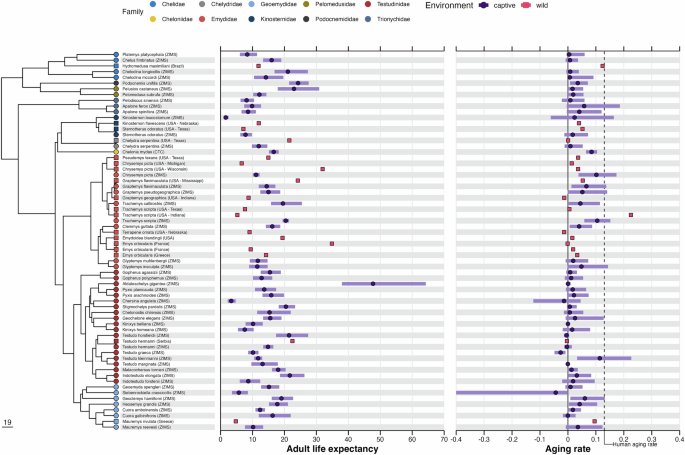
Shaded bars represent either 95% credible intervals (non-sea turtle species3,4) or 95% confidence intervals (sea turtle species). Uncertainty estimates were computed using either Bayesian survival trajectory analysis (BaSTA) or the Delta Method. Tree tip color indicates family, and shapes and colors for aging rates and life expectancies show environment (i.e., captive (blue circles) versus wild (red squares)).
Differences in reproductive dynamics between OTN and MSN translated into distinct mortality functions (Figs. 1B and 2B). This distinction was captured by including a covariate for reproductive status (SI Appendix, Table S2), which provided a better fit to the data over assuming additional unobserved heterogeneity (via a Gamma-Makeham frailty model52,53). Initial mortality rates, which were 25% lower for MSN, shaped these differences. Both life expectancy (KLD = 1.0) and lifespan inequality (KLD = 1.0) were significantly different between OTN and MSN (SI Appendix, Fig. S3 and Table S3–4), with OTN having a 52% shorter reproductive lifespan (({e}_{x}^{{OTN}}) = 10.2; ({e}_{x}^{{MSN}}) = 19.6) and greater variance in age at death (({H}_{x}^{{OTN}}) = 0.6; ({H}_{x}^{{MSN}}) = 0.4). We estimated 5% of captive green turtles will survive beyond 23.4 (OTN) and 35.5 (MSN) years old, and 1% will live past 27.6 (OTN) to 39.6 (MSN) years old. Their respective aging rates correspond to a mortality doubling time of 6.7 years for OTN and 7.4 years for MSN. Whether mortality and reproductive estimates for MSN and OTN reflect individual variation in response to captivity remains unclear40. However, since individuals in the study primarily reflect the original, diverse genetic founder stock, our results are unlikely a result of inbreeding depression54.
The most common age at death (modal age; estimation based on method in ref. 55) was 10 years for OTN and 24 years for MSN. This earlier modal death age for OTN, coupled with a significantly greater variance (see ({H}_{x}^{{OTN}}) above) suggests that deaths occur earlier on average but are more dispersed. In contrast, the narrower age range of death for MSN may indicate a more consistent timing of when late-life physiological decline leads to mortality. The earlier modal age for OTN aligns with an earlier onset of actuarial senescence post-maturity, although we could not attribute this to reproductive costs. Contrary to predictions about the timing of peak mortality36, significant increases did not begin shortly after sexual maturity for MSN but occurred approximately 12 years post-maturity (at 24 years of age), indicating a substantially delayed period before peak mortality risks manifested. This phenomenon of deferred actuarial senescence in MSN, where the primary escalation of mortality risk is postponed, has also been reported in endotherms56 and ectotherms3,4.
To explore the interplay between survival and reproduction further, we focused solely on MSN, as these individuals not only actualized the most common reproductive strategy of green turtles but also allowed us to evaluate how reproductive costs impact survival over successive breeding seasons. Recalling that cumulative reproductive output increased linearly through much of early to mid-adulthood and given that their peak mortality (modal age at death) occurs at around 24 years, the later inflection point in their reproductive trajectory (27 years; Fig. 1) suggests that mortality risk begins to accelerate before any observable decline in reproductive output. While we found no evidence that a higher annual reproductive rate or earlier maturity led to an earlier decline in egg production, the mortality pattern in MSN points to a potential trade-off between current reproduction and future survival.
Comparing mortality and reproductive patterns between captive and wild green turtles
Surprisingly, our estimate for reproductive longevity for captive green turtles (19.6 years post-maturity) closely matches those reported for wild Australian green turtle populations (18–19 years)57. Differences in longevity between captive and wild populations seem to be related to maturity time. Although green turtles may remain reproductively active for ~19 years, the waiting time to first reproduction is reduced by around 32% in captivity. Wild green turtles spend almost half their lives gathering the necessary resources to reach a minimum body size needed to meet the requirements for long-distance migration and reproduction, which is related to environmental, developmental, and physiological constraints58. Once mature, differences in reproductive rates relate to the time required to gather resources for a subsequent breeding season. In captivity, turtles do not need to migrate thousands of kilometers between breeding and foraging grounds, significantly reducing their energetic costs and increasing their reproductive rate. However, in wild leatherback turtles the stress of reproducing at a higher frequency had negative physiological effects59, suggesting a trade-off between current and future reproduction that influences lifetime reproductive success60.
Limited resources compounded by extensive migrations result in wild green turtles having fewer reproductive seasons compared to those in captivity. If wild populations follow a similar reproductive trajectory as shown in Fig. 1A, we project a 20-year reproductive lifespan with an inter-breeding interval of two and four years would result in a lifetime output of between 1324 and 4080 eggs – a figure close to the estimated lifetime reproductive output in wild Australian green turtles ( ~ 2000 eggs61). Yet, such projections from captive populations are speculative. Data from known-aged sea turtles would greatly enhance comparative analyses. Despite the hundreds of global projects monitoring sea turtle populations, several operational since the early 1960s, no long-term longitudinal data exist for known-age sea turtles of any species, rendering the estimation of age-specific mortality and reproductive rates particularly challenging62. The inability to accurately determine the absolute chronological age of living wild sea turtles remains the single most significant impediment to precisely understanding their life history63. This limitation impedes the employment of typical demographic tools64 to understand phenotypic variation and plasticity in wild populations experiencing vastly differing ecological pressures.
Alternative approaches have emerged that circumvent the need for aging live animals and allow for the construction of age- and size-specific reaction norms65. While undoubtedly valuable, such methods cannot translate into direct, individual-level changes in reproductive output and survival over a full lifespan, nor can they fully capture the dynamic interplay of environmental factors. For instance, if aging rates are environmentally modulated, as observed in other testudines3 rather than an underlying change in juvenile mortality as seen in primates66, wild populations of sea turtles may experience mortality rates that vary with local selective pressures, such as foraging ground productivity67, predation, disease, temperature regimes, and climate change68. These factors are known to strongly influence species-specific vital rates across testudines. In painted turtles, aging rates vary between and within wild and captive populations (captivity: 0.0919, 0.103; wild: 0.044, 0.014, 0.1025). Comparable results have been reported in pond sliders Trachemys scripta3,4, as well as European pond turtles Emys orbicularis4. This environmental sensitivity has important implications in understanding selection for lifespan-extending mechanisms in long-lived species, which is expected to be strong. When extrinsic mortality is low and aging-related mortality is high, as is the case in certain birds and mammals42,69, extending lifespan further would likely come at a high evolutionary cost. Life extending mechanisms may be less costly in terms of evolutionary fitness for testudines when actuarial senescence is not the primary source of mortality42, but this needs to be evaluated with empirical data. While direct longitudinal studies of known-aged individuals in the wild remain paramount, at present, research on the paradoxical life history of sea turtles can be most effectively advanced by tracking individuals from their first breeding season, employing breeding age rather than absolute age.
Comparing mortality and reproductive patterns across captive and wild testudines
To situate our findings on captive green turtles within the broader evolutionary landscape, we conducted a comparative analysis across testudines. Captive green turtles exhibit aging rates similar to those of other testudines (Fig. 3), and the relationships among fitness-related traits in testudines (including sea turtles) generally align with established life-history patterns3,4,19, irrespective of environment. For instance, an earlier age at first reproduction is linked to a shorter lifespan and body mass is positively correlated with life expectancy (SI Appendix, Fig. S4A, B). A notable divergence, however, emerges in their reproductive investment: green turtles produce a disproportionately heavier reproductive mass relative to their aging rate, life expectancy, and AFR (Fig. 4A–C). Despite this difference, the allometric relationship between reproductive mass and body mass in green turtles matches theoretical expectations (Fig. 4D), a pattern that also holds across wild sea turtle species70. Extensive migrations between foraging and breeding grounds impose strict physiological constraints, making the large body size of sea turtles an evolutionary prerequisite for their highly migratory, oceanic lifestyle71. In general, a larger body size offers significant adaptive advantages, including reduced predation risk, a lower mass-specific metabolic rate, and greater starvation tolerance. However, these benefits are balanced by higher resource requirements, a longer maturation period, and increased susceptibility to extinction due to longer generation times.
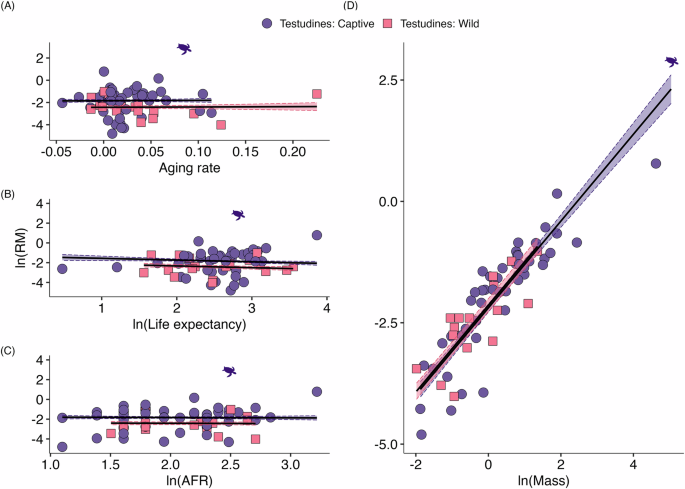
Solid lines indicate the fitted model, and shaded areas are 95% CI. Estimates for captive green turtles in plots (A–D) are shown by the green turtle silhouette, sourced from PhyloPic. AFR denotes age at first reproduction.
Across testudines, we found aging rates do not strongly vary along a slow-fast continuum as typically defined by other life-history traits. Notably, the relationship between aging rates and body mass, AFR, and annual fecundity are substantially weaker than in other reptiles4 (Fig. 5A–C). Collectively, these traits explained only 8% of the variation in aging rates (Table 1A). While the direction of these relationships is similar to other reptiles (excluding testudines), the effect sizes are trivial, yielding nearly flat lines across taxa with different fecundities (slope: testudines = 0.01, reptiles = 0.11), ages at first reproduction (slope: testudines = −0.01, reptiles = −0.18), and body masses (slope: testudines = 0.00, reptiles = −0.03). Furthermore, while wild populations in our dataset exhibit slightly faster aging rates, this difference was not statistically significant (Table 1A, Fig. 5).
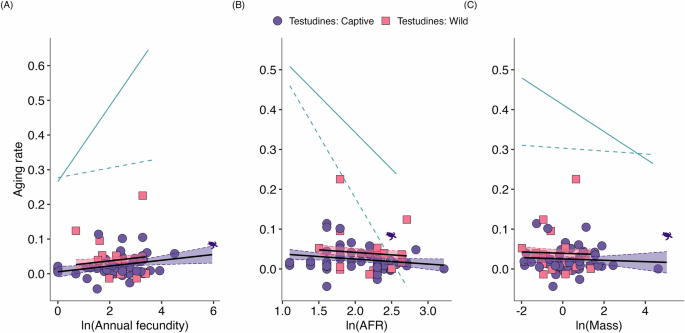
Solid lines indicate the fitted model, and shaded areas are 95% confidence intervals. Predictions for aging rates from Reinke et al. 4 including (teal dashed line) and excluding (teal solid line) their testudine data. Estimates for captive green turtles in plots (A–C) are shown by the green turtle silhouette, sourced from PhyloPic. AFR denotes age at first reproduction.
Consistently slow aging rates across testudines, despite substantial differences in body size, environmental conditions, and habitat use, likely stem from a weakening of life-history trade-offs. Shared protective phenotypes (e.g., shells) and physiological adaptations, such as the ability to endure food scarcity while keeping maintenance costs low relative to energy storage72, may buffer testudines against selective pressures that typically drive diverse aging trajectories in other groups. The stronger relationships reported by Reinke et al.4 appear predominantly driven by high variation in squamates, with crocodilians and tuataras showing aging patterns more aligned with testudines. Similarly, the correlation between mortality and AFR in Shine and Iverson73 arises from methodological distinctions between age-specific mortality and instantaneous adult mortality ((-{mathrm{ln}}({{rm{S}}})), where S is a point estimate for adult survival probability). Our results suggest that, within testudines, the expected covariance among life-history traits with aging rates along a slow-fast continuum is not evident because they collectively occupy the slow extreme of this broader spectrum (see also Fig. 4 in ref. 4).
While variation in reproductive mass does not directly align with the slow-fast continuum, it correlates strongly with body mass – a trait that itself is indicative of a species’ position on that continuum (SI Appendix, Fig. S4A, B). Female body mass in testudines explained 81% of the variation in annual reproductive mass (Fig. 4D). Other life-history traits, such as life expectancy, AFR, aging rate, and environment, did not explain the residual variation, and their effect actually became trivial once body mass was prioritized in a sequential decomposition of variance (Type I ANOVA). The dominant role of body size is anticipated, given its fundamental importance to organismal fitness, and it is both heritable74 and exhibits plastic responses to changing environments75, particularly during ontogeny30. In line with scaling laws76, which predict reproductive mass should follow a power function of the form (alpha cdot {M}_{F}^{beta }), we estimate the scaling exponent ((beta)) to be 0.89 (95% CI: 0.77–1.02), suggesting hypoallometric scaling. This result aligns closely with findings across sea turtles70 and testudines in general77, whereby larger species produce relatively lighter clutches (slope ≈ 0.77 in ref. 77). Interestingly, among individuals of the same species, this pattern is reversed (hyperallometric scaling)70,78.
Although inter-specific hypoallometry might imply reproduction carries a proportionally higher allometric cost for smaller species, we found no detectable direct effect of reproductive mass itself on aging rates (p = 0.87), AFR (p = 0.86), or life expectancy (p = 0.21). Reproductive mass was slightly heavier in captivity (Table 1B and Fig. 4), but this difference was not significant (∆captive-wild = 0.05; p = 0.77). Although univariate tests detected a strong phylogenetic signal for both reproductive mass and body mass (Pagel’s λ; SI Appendix, Fig. S5 and Table S5), evolutionary relatedness did not explain the residual variance for reproductive mass, nor aging rates in the PGLS models (SI Appendix, Table S6). Instead, life-history trade-offs associated with the magnitude of reproductive investment primarily manifest through adjustments in other life-history components (SI Appendix, Fig. S4), such as age at first reproduction and overall life expectancy (as suggested by correlations with body mass). For instance, turtles and tortoises are constrained by the size of their body cavity, which is affected by their overall body plan. As such, there is a trade-off between the number of eggs and egg size79. Egg size is expected to be subject to stronger directional selection than clutch size, as each egg must provision all essential resources required for hatchling survival. Empirical data support this hypothesis, finding that clutch size shows greater phenotypic variance relative to egg size80. Patterns of reproductive allocation may largely reflect these allometric and anatomical constraints, especially as both clutch and egg size generally increase with body size across testudines81, rather than being strongly lineage-specific72.
